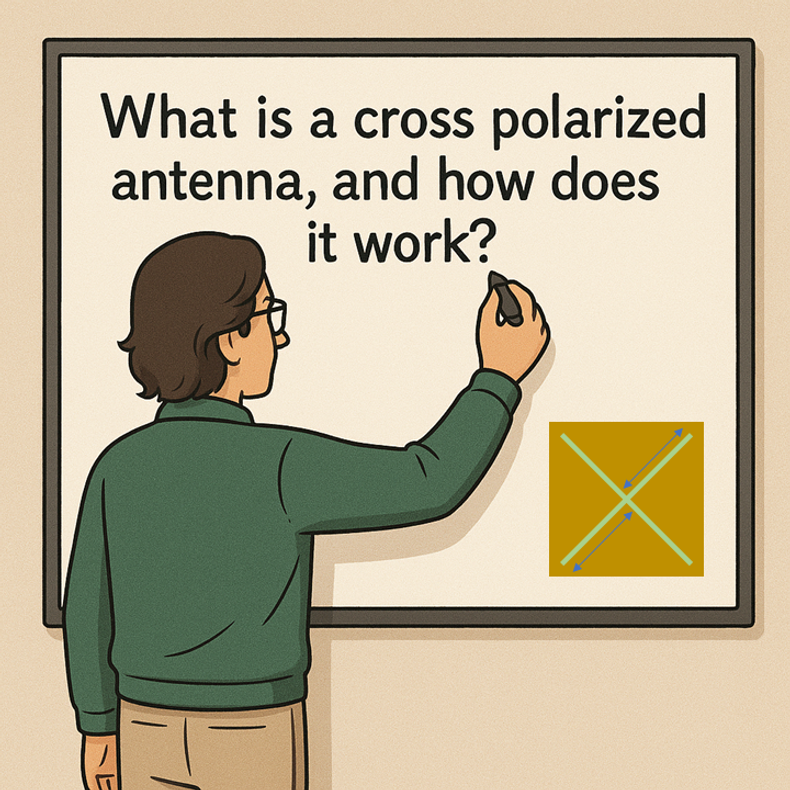In the scope of wireless communication, antenna design plays a crucial role in performance, scalability, and spectral efficiency. One of the most impactful advances in RF engineering for modern networks is cross-polarization, often referred to as X-polarization or XPOL. This design principle enables antennas to simultaneously transmit and receive signals on two orthogonal polarizations, typically at ±45 degrees, delivering significant advantages in throughput, interference mitigation, and MIMO optimization.
At AG Antenna, we specialize in engineered antenna solutions that meet the real-world demands of enterprise connectivity, industrial IoT, and private LTE networks. This post explores what X-polarization is, why it matters, and how it enhances the performance of next-generation wireless systems.
What Is Cross-Polarization?
To understand cross-polarization, we must first explore the concept of polarization in radio frequency transmission. Polarization refers to the orientation of the electric field in an electromagnetic wave. In most systems, this is either vertical or horizontal, but more advanced systems use circular or slant (angled) polarization for performance and diversity benefits.
X-Polarized antennas use two polarizations offset by ±45 degrees, housed within the same antenna radome. These polarizations are orthogonal, meaning they are isolated from one another and can carry separate data streams simultaneously. This design is a foundational requirement in 2x2, 4x4, and 8x8 MIMO (Multiple Input, Multiple Output) networks, where cross-polarization allows full spatial diversity without the need for multiple physical antennas.
Technical Advantages of X-Polarized Antennas
Cross-polarized antennas offer a number of performance benefits, particularly in challenging RF environments where high reliability and speed are required:
- Improved Signal Isolation
X-polarization enhances isolation between RF channels, reducing co-channel interference and adjacent channel leakage. This results in cleaner signals, lower packet loss, and more reliable links, particularly in high-density deployments.
- Enhanced Throughput
By leveraging multiple, orthogonal signal paths within a single antenna structure, X-polarization enables higher-order MIMO operation, effectively doubling the data rate capacity when paired with compliant radio equipment.
- Optimized for Multipath Environments
Urban, industrial, and obstructed settings often introduce multipath propagation. Cross-polarized antennas take advantage of these reflections by maintaining decorrelated paths, helping receivers distinguish between them and improving link robustness.
- Spectral Efficiency
When frequency reuse and spatial diversity are critical, as in CBRS and private LTE systems, X-polarization supports dense deployments with minimal interference—enabling high user density per cell and superior overall system performance.
Key Applications for Cross-Polarized Antennas
The capabilities of X-polarized antennas make them particularly valuable in the following scenarios:
- Private LTE and CBRS Networks: Supports reliable coverage across licensed and shared spectrum.
- Carrier-Grade 5G Deployments: Essential for sub-6GHz MIMO configurations.
- Fixed Wireless Access (FWA): Provides high-bandwidth connectivity over long distances.
- Utility and Smart Grid Communications: Enhances link stability in mission-dependent infrastructure.
- Dense Urban or Industrial Campuses: Reduces interference and enhances spectral reuse in crowded RF environments.
Considerations in Deployment
To fully capitalize on X-polarization, proper deployment practices are essential:
- Mounting and Alignment: Antennas must be correctly oriented to preserve polarization integrity, particularly for slant-polarized systems.
- Isolation Performance: Look for antennas with high port-to-port isolation (typically >20 dB) to ensure optimal signal separation.
- Connector Management: Dual-polarized antennas require careful labeling and routing to connect each polarization path properly.
- Environmental Durability: Industrial-grade designs with UV resistance, wide temperature tolerance, and IP67+ ratings ensure long-term reliability in harsh conditions.
AG Antenna’s X-Polarized Solutions
At AG Antenna, our portfolio includes ruggedized, high-performance cross-polarized antennas specifically engineered for multi-network routers and enterprise-grade deployments. Our solutions are:
- Tuned for MIMO Efficiency: Supporting 2x2 to 4x4 cellular and Wi-Fi configurations.
- Built for Integration: Compatible with leading OEMs such as Ericsson Cradlepoint, Semtech Sierra Wireless, Peplink, Digi, Inseego and others.
- Engineered for Performance: High isolation, low VSWR, low PIM, consistent radiation patterns, and optimized axial ratios.
- Available in Multiple Form Factors: From MIMO yagi antennas to MIMO panel antennas, supporting a wide range of applications.
AG Yagi XPOL Series Cross Polarized Directional MIMO 2x2 Cellular Network Antenna
AG-DP2C XPOL Series Directional MIMO 2x2 Cellular Panel Antenna
AG-DP4C XPOL Series Directional MIMO 4x4 Cellular Panel Antenna
Whether it’s deploying private LTE across utility substations or maximizing bandwidth in a smart factory, AG Antenna’s cross-polarized solutions are built to meet the demands of advanced wireless ecosystems.
Why Polarization Diversity Matters
As wireless networks evolve, so do the challenges of bandwidth allocation, device density, and environmental interference. Polarization diversity is not just a performance boost, it’s a necessity. Cross-polarized antennas enable:
- High-capacity communication in limited spectrum
- Reduced tower load by minimizing antenna count
- Greater flexibility in leveraging multi-network deployments
By equipping your infrastructure with polarization-diverse antennas, you’re building a future-ready network capable of adapting to emerging standards and unpredictable RF environments.
Cross-polarization is a game-changer for modern wireless systems. By integrating two orthogonal signal paths into a single antenna, X-polarized antennas offer superior throughput, better interference mitigation, and optimized multipath handling. At AG Antenna, we engineer cross-polarized solutions that meet and exceed the demands of real-world field deployment, whether it’s a utility pole, cell tower, or mobile router installation.
Contact AG Antenna today to learn more about how our X-polarized antenna designs can elevate your wireless performance.

